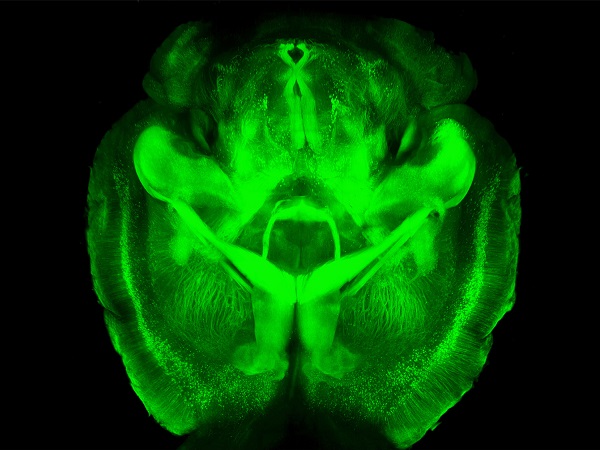See-through brain shows what’s on your mind

This undated image provided by Karl Deisseroth’s lab shows a three-dimensional rendering of clarified mouse brain seen from below. Scientists have made mouse brains transparent, permitting a comprehensive and exquisitely detailed view of their inner structures, providing a major new tool for research. “You get the big picture without losing track of the details,” said Dr. Karl Deisseroth, who led the Stanford team that reported the work online Wednesday, April 10, 2013 in the journal Nature. Some other labs are already working to apply the technique on other kinds of tissue, such as for studying breast cancer biopsies, Deisseroth said. AP/Karl Deisseroth
PARIS—Scientists in the United States have developed a method to make a disembodied brain transparent, allowing them to study the organ’s intricate wiring without having to slice it up.
The feat in chemical engineering has been demonstrated on a brain taken from a mouse, and further tests shows it also works on brain segments from zebrafish and humans, it said.
The process, dubbed CLARITY, will revolutionize three-dimensional study of brains and possibly other organs after they are removed from the body, according to the paper, published in the journal Nature on Wednesday.
“Studying intact systems with this sort of molecular resolution and global scope—to be able to see the fine detail and the big picture at the same time—has been a major unmet goal in biology,”said Stanford University bioengineer and study leader Karl Deisseroth.
The brain is the most important organ of the body, yet how its circuitry works remains largely obscure.
The view into the brain is blocked by opaque, fatty molecules called lipids that help form membranes around cells and bind the tissue together.
Scientists seeking access to structures deep in the brain have to make microscopic slices of the organ and then scan the images, slice by slice, before reconstituting an image on a computer.
CLARITY replaces the lipids with a clear, water-based gel, preserving the tissues intact while revealing the brain’s fine internal structure.
The gel is injected into the brain and penetrates the tissue, forming a mesh that holds the working components together.
The lipids are then extracted using an electrochemical process without the organ falling apart, leaving all the preserved cells and wiring open to scrutiny.
“What remains is a 3-D, transparent brain with all of its important structures—neurons, axons, dendrites, synapses, proteins, nucleic acids and so forth—intact and in place,” said a statement from Stanford University, which conducted the research.
Once the organ is rendered transparent, the scientists can use light and chemicals to trace individual neural connections and relationships between cell groups.
They can use fluorescent proteins to give different colors to individual nerve fibers, and use an electron microscope to study ultra-fine structures like synapses, the connections between neurons.
After their success in mice and then zebrafish, the team tested their method on post-mortem human brain sections.
In the frontal lobe of a seven-year-old autistic boy, they traced individual nerve fibers and noticed unusual “ladder-like patterns” in the neurons.
CLARITY “promises to transform the way we study the brain’s anatomy and how disease changes it,” commented Thomas Insel, director of the US National Institute of Mental Health.
“No longer will the in-depth study of our most important three-dimensional organ be constrained by two-dimensional methods,” he said.